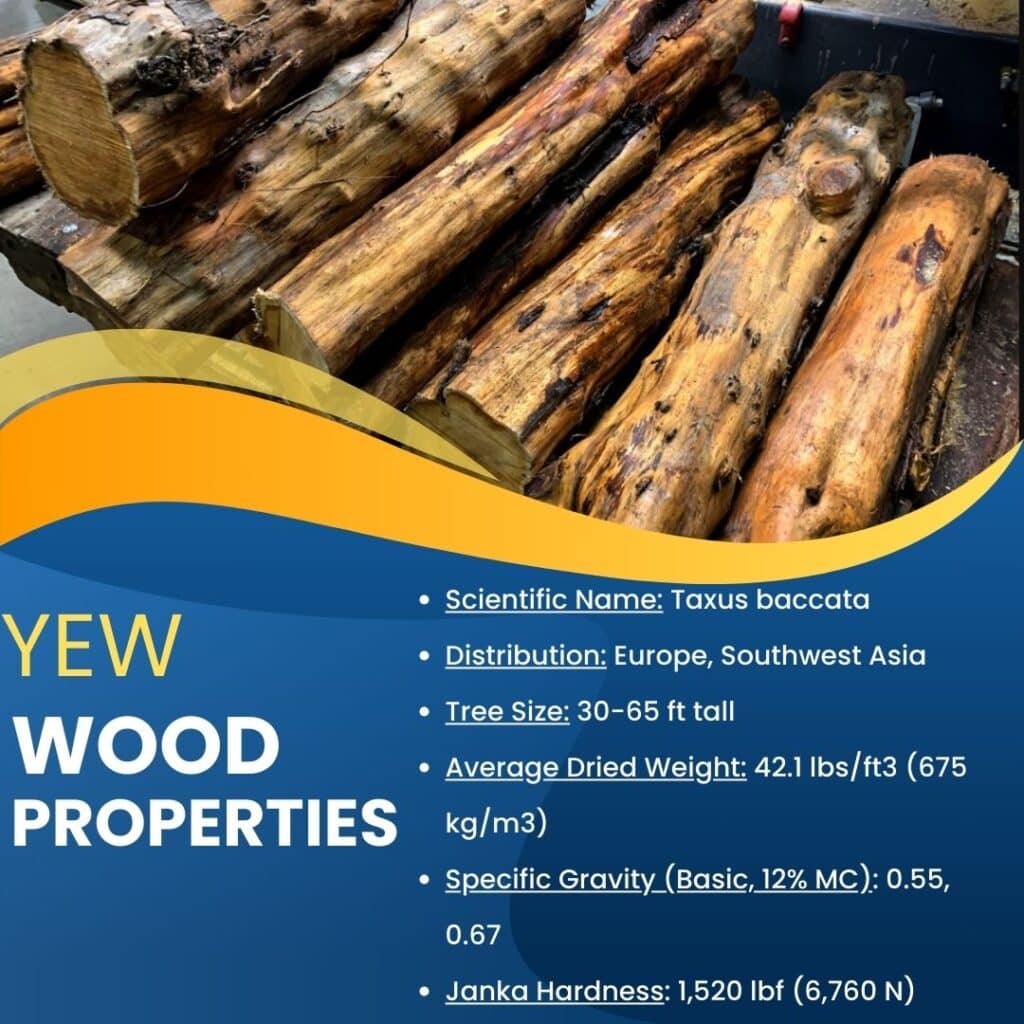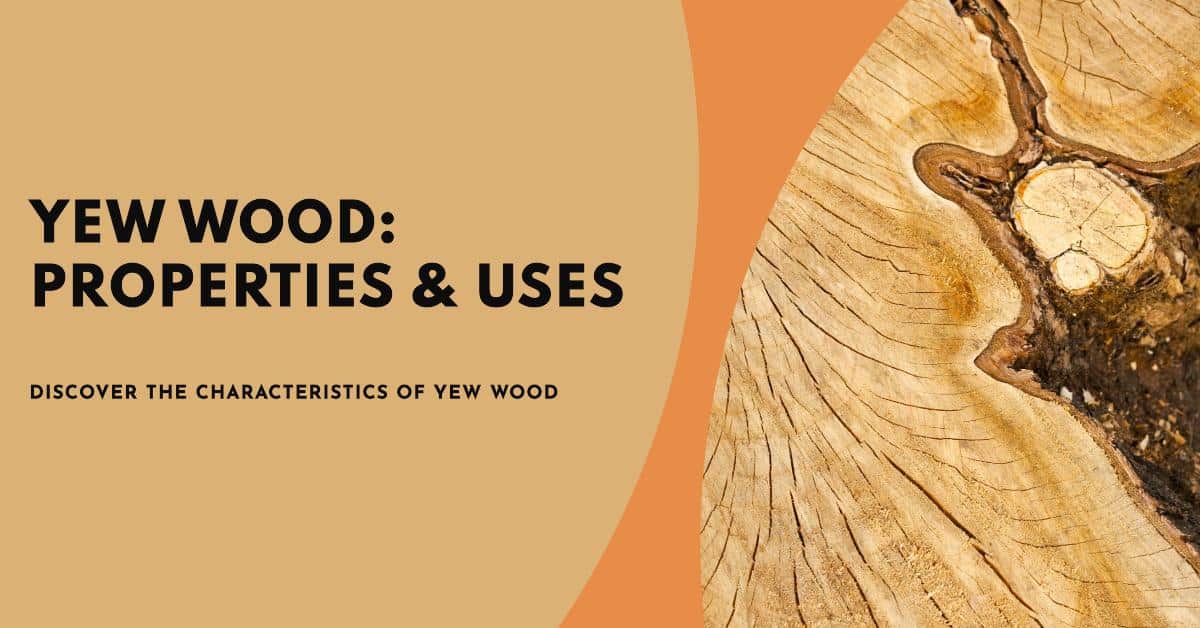Yew is a conifer (softwood) tree in the family Taxaceae. With more than 40 species, including both large trees and small shrubs, Yew wood has an extensive presence across Asia, central Europe, North Africa, and America.
The timber of yew trees is yellow or orangish brown and is known for its exceptional durability with good resistance to decay and insects. It’s also easy to work with, which makes it a favorite of woodworkers. The problem is its lack of availability in large sizes and the presence of knots on the surface, which makes it expensive. It is considered ideal for a variety of wood projects, from furniture making to turned objects and carvings.
Yew Wood Properties & Characteristics
Despite being a softwood species, yew is remarkably hard and durable and considered suitable for various applications. Today, we take an in-depth look into the properties and applications of common Yew wood, starting with a brief introduction to the Yew tree.
About Yew Tree
This tree belongs to the Taxaceae family and is a slow-growing coniferous tree found commonly in temperate and tropical mountainous forests worldwide. With heights ranging from 8 feet to an astonishing 130 feet, these trees have flat, dark-green leaves arranged spirally, with lengths ranging from 10 to 40 mm. The tree trunk, with a diameter typically around 5-6.5 feet, has a thin, purple-brown, or reddish bark that is smooth in the beginning but transitions to scaly or fibrous with age. Like all conifer trees, it has cones in place of fruits. The female cones yield a singular seed and measure about 8-15 mm long. The tree crown shape ranges from a dense pyramid to an irregular form. It has great ornamental value and importance, particularly in urban landscapes, where it helps defy pollution while being attractive.
Yew Wood Properties in Detail

Appearance
Yew wood features a distinctive appearance with the sapwood being a thin, pale yellow or tan and the heartwood displaying an orangish-brown hue, which is occasionally tinged with dark brown or purplish tones. The grain pattern is visible and prominent. As the wood matures, the color deepens. It has many knots throughout the surface. The grain is straight and the texture is fine and uniform. The wood boasts good natural luster, adding to its overall aesthetic appeal.
Strength
Even as a softwood, it embodies a high level of strength and flexibility, making it an ideal choice for crafting archery bows. Its combination of resilience and pliability contributes to the exceptional performance of these weapons.
Density & Weight
It showcases a remarkable density with an average dried weight of 42.1 lbs/ft3 or 675 kg/m3. The substantial weight contributes to its usability and stability, enhancing its suitability for various applications, including archery bows. The wood’s density is considered a key factor in its strength and overall performance in different uses.
Hardness
Yew wood can be considered harder than most softwoods due to its excellent Janka Hardness rating of 1,520 lbf (6,760 N), ranking it among the hardest commercial woods. This exceptional hardness contributes to its strength, making it suitable for heavy-duty applications.
Durability & Resistance
European yew, which is the most popular commercial species of yew, boasts durability ranging from durable to very durable in terms of resistance to moisture and decay. Additionally, it is also well-protected against most insect attacks, which further enhances its longevity and suitability for various applications. The wood can be used for both interior and exterior purposes and lasts very long with basic maintenance.
Workability
Despite being hard, Yew timber is an easily workable material, though the presence of knots and occasional irregular grain might pose challenges. Nevertheless, it works wonderfully in gluing, finishing, and turning. Its cooperative nature in various woodworking processes makes it a favored choice of woodworkers, despite occasional complexities arising from its unique grain patterns and knots.
Pricing & Availability
Yew wood is not very commonly available, and the available large trees often have hollow trunks with limited uses. Moreover, the presence of knots and irregularities can render most of the tree useless. While small units may be available at moderate prices, the overall cost of usable large timber tends to be high, depending on the availability in a location.
Use of Yew Wood
As a flexible and strong wood with good durability, yew timber finds applications in a variety of projects. Here are some examples:
1. Bows (Archery)
It is famously used for crafting archery bows. Its unique blend of strength and flexibility makes it a perfect material, providing the necessary attributes for effective and high-performance bows for use in the sport of archery.
2. Veneer
Yew lumber is also commonly used for producing veneer, which refers to a thin layer of wood used to cover surfaces for protection or as a decorative element. The wood’s beautiful appearance, fine texture, and straight grain make it a desirable choice for producing beautiful veneer to enhance the aesthetics of furniture and other wooden items.
3. Cabinetry
Another popular application of Yew wood is in cabinetry, where it is used for the construction of durable and visually appealing cabinets for kitchens, drawing rooms, and other areas. Its outstanding workability, fine texture, and natural resistance to decay make it a valuable material for crafting high-quality cabinetry pieces.
4. Furniture
It is used in crafting beautiful furniture pieces that are strong, durable, and good-looking. Due to its unique appearance, it fits well in various furniture styles, providing a balance between elegance and sturdiness.
5. Carvings and Moldings
The ease of working makes it suitable for intricate carvings. Since it cuts and turns well and has a fine texture, it can be used for detailed and precise carving and turning applications, making it a preferred material for creating decorative and artistic pieces in woodworking.
6. Musical Instruments (Lutes)
Yew lumber is also occasionally used for the construction of musical instruments, particularly lutes. Its resonance, easy workability, and aesthetic appeal make it a solid choice for producing visually appealing and auditory excellent instruments.
7. Turned Objects
It is well-suited for turning on a lathe, which makes it ideal for building various turned objects, such as bowls, spoons, and more. Its workability, coupled with its fine texture and natural luster, allows for the production of beautiful turned wood items.
Advantages and Disadvantages of Yew Wood
Advantages:
- Durable and Long-lasting: Highly resistant to rot and decay.
- Strong and Flexible: Ideal for items requiring tensile strength.
- Attractive Appearance: Fine, close grain with a reddish-brown color.
- Workability: Easy to work with for detailed designs.
- Versatile: Used for furniture, cabinetry, and specialty items.
- Natural Resistance: Contains oils that resist insects and fungi.
Disadvantages:
- Expensive: High cost due to limited availability.
- Toxins: Contains toxic compounds requiring careful handling.
- Scarce: Limited supply from slow-growing trees.
- Allergenic: Can cause allergic reactions and skin irritation.
- Heavy: Dense wood that can be difficult to work with.
- Maintenance Required: Tends to darken with age and light exposure.

